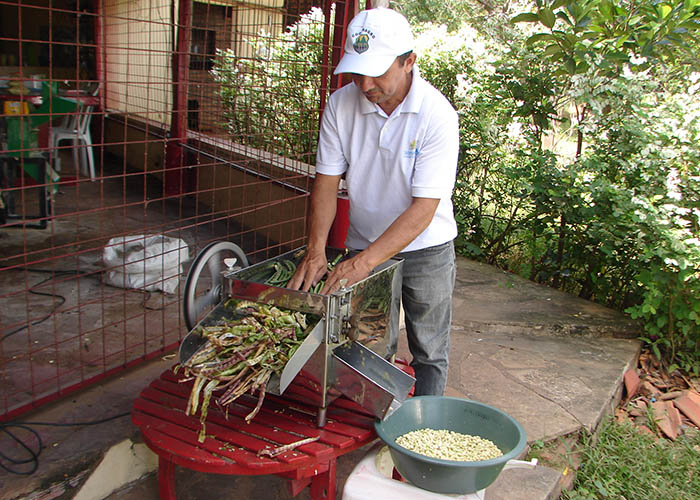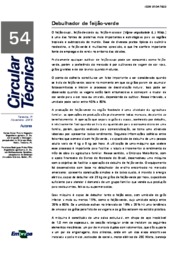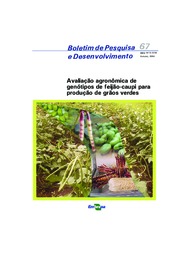Machine makes fresh bean processing five times faster
Machine makes fresh bean processing five times faster
A machine that quintuples the productivity of cowpea threshing is going to help thousands of family farmers who work with this crop in the Brazilian Northeast. The manual process of separating the pea from the pod, known as threshing, when executed by an adult person, yields about four to six kilos per hour. With the machine, the smallholder is able to thresh up to 25 kilos of fresh beans per hour.
Developed with the support of Banco do Nordeste by the researchers César Nogueira, from Embrapa Mid-North (Teresina, Piauí), and Francisco Freire Filho, Embrapa Eastern Amazon (Belém, Pará), the equipment measures 45 centimeters in length and 43 in height, weighs 12 kilos, and is powered by a 250-Watt electric engine. The project is freely available for cooperative unions and farmers' associations that are interested in building the equipment.
“Such advance accelerates the results of labor and increments income”, underscores César Nogueira, as he recalls that threshing 25 kilos of fresh beans per hour is enough to meet the demands of family groups who sell their production to restaurants, supermarkets, and in fairs.
The production of fresh beans in the Brazilian Northeast, especially from the cowpea species (Vigna unguiculata), occurs manually from sowing to processing. Nogueira explains that the threshing process is relatively easy when dealing with the amount for a family's daily consumption. “However, when the activity aims at trade, it becomes an exhausting job with low yield”, the scientist stresses.
“It is important that farmers learn that the machine can be also used to thresh the unripe or ripe cowpeas, with grain moisture content below 15%”, details the researcher. When threshing them when they are green, the grain moisture content must be between 35% and 60%. “But if the moisture ranges between 16% and 35%, it is likely that the grains will be flattened, as the pods and the peas are then at their plastic stage”, he warns.
The right time to harvest
Another guideline given by the researchers, which must be strictly followed by farmers, concerns the time of harvest. Farmers who produce fresh beans know the ideal time. It occurs when the pods reach the maximum volume of development and start to change from the color green into purple or yellow, depending on the cultivar.
At this moment, the grains reach their maximum weight. In other words: it is the point when the grains stop growing, and the process of natural dehydration begins. That is important from an economic standpoint, because the grain yields more and can be better processed. According to Nogueira, in this period moisture can vary between 40% and 60%.
Simplicity
Created to be used in farmers' markets, the machine is simple, easily built and low cost. If produced at the Embrapa unit in Teresina, Piauí, it cost around or a little over R$ 800.00. If it is produced in a series of at least ten, their price drops to R$ 500.00 a piece or even less, according to César Nogueira.
The researchers took two years to develop the thresher and counted on R$ 15,000 of investments. To get to the definitive machine project, the scientists sought inspiration for the details in a pea thresher that was developed in the United States.
Revolution in family farming
The first agricultural community to benefit from the thresher was the Portal do Parnaíba Farmers' Cooperative (Cooperagro), in the northern rural zone of Teresina. Twenty families have already tested the machine for around a year, and they were able to turn their lives around with it. “This threshing machine is a revolution in family farming”, praises Marcos Venicíos Andrade de Araújo, 48, president of the cooperative.
According to him, with the use of the machine, Cooperagro made a leap in efficiency in fresh bean processing. “What once seemed impossible has become a reality today. Before, we would thresh an average of 30 kilos of cowpeas per day. Today, with a single operator, we managed to reach about 200 kilos per day”, Araújo celebrates.
Besides the speed in processing fresh beans, which have a short shelf life, the thresher has allowed farmers to space out sowing, with irrigation, so that they can harvest the product at the right time. “We can now meet the needs of the consumer market with more expeditiousness and precision”, Araújo celebrates.
Model cooperative member
Domingos Ferreira Silva, 50, aka Dominguinho, a health agent for Teresina's city government and a farmer in his free time, stood out at Cooperagro for his cowpea production. Having always worked with cowpea cultivar BRS Guaribas, developed by Embrapa, he was the cooperative member who obtained more net gains in 2016 and the farmer who benefited the most from the thresher in the cooperative.
In addition to earning a thousand reais every month, Dominguinho obtained 6,000 reais of net gains by the end of the last year. He was also nominated a model cooperative member due to his performance in the production, processing and commercialization of fresh beans. By himself, he produced 1,2 ton in little more than one hectare. “It was a large effort that we made, in my hours off duty from the work at the city hall, to obtain this production”, he explains.
“The thresher developed by Embrapa is a major advance to improve the lives of agricultural communities in Portal do Parnaíba,” Dominguinho considers. The cooperative member states that families are enthusiastic about the perspective of increasing fresh bean production throughout the year. “That is because the hard work of threshing by hand is over. It is an evolution”, he declares.
When Cooperagro was still in construction, it was able to produce, process and trade about three tons of fresh beans last year, at the cost of twelve reais per kilo, raising nearly R$ 40,000. Incidentally, the cooperative produces, processes and sells cassava, another Northeastern product of strong culinary appeal in the whole country.
| Strategic and a source of protein The researcher Francisco Freire Filho recalls that cowpeas or black-eyed peas (Vigna unguiculata), known in Brazil's Northeast as "feijão caupi", "feijão de corda" or "feijão macassar", are still one of the most important protein sources in the tropical and subtropical regions of the world. In Northeastern Brazil, it is strategic for food security and has generated jobs and income. The crop has also gained momentum and strength in the agricultural production of the North and Midwest regions of the country. Mato Grosso is the state that has been leading in cowpea production in recent years. In 2015, for instance, according to the Systematic Agricultural Production Survey by the Brazilian Institute of Geography and Statistics (IBGE), 230,897 tons were produced in a harvested area of 224,683,000 hectares. Of African origin, cowpeas arrived in Brazil in the second half of the sixteenth century, through the state of Bahia, the then administrative center of the country, through the hands of the Portuguese settlers. From there, the product was taken to other Northeastern states, where it made it to countrymen's agriculture and tables. |
Translation: Mariana Medeiros
Fernando Sinimbu (654 MTb/PI)
Embrapa Mid-North
Press inquiries
meio-norte.imprensa@embrapa.br
Phone number: +55 86 3198-0518
Further information on the topic
Citizen Attention Service (SAC)
www.embrapa.br/contact-us/sac/




